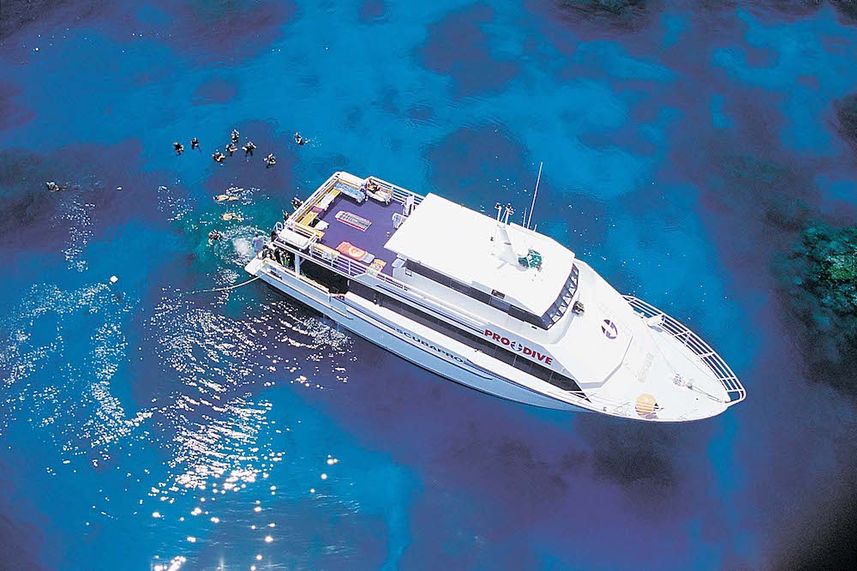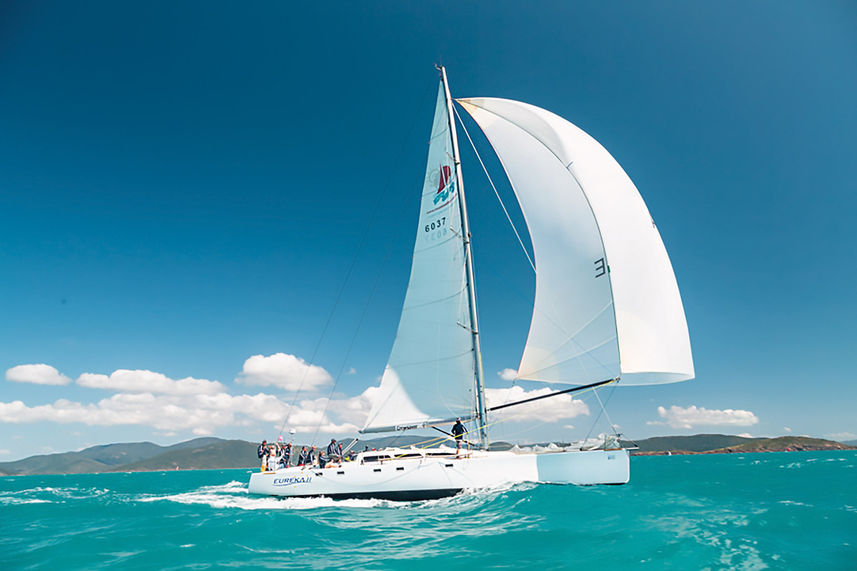Scuba Diving Australia
- May 9, 2024

Disclaimer: This article contains affiliate links. We may receive a small commission if you make a purchase through one of these links. Read our Affiliate Disclosure for more information.
Thinking about scuba diving in Australia?
This is our complete dive travel guide. Read on to find out everything you need to know about scuba diving in Australia.
Or jump directly to booking your stay.
Australia, the land down under, beckons not only with its iconic wildlife, but also with a vast underwater world waiting to be explored. From the vibrant coral reefs of the east coast to the bioluminescent wonders of the south, Australia offers a dive experience unlike any other.
Unparalleled Biodiversity: Australia boasts an incredible range of marine ecosystems, each teeming with unique life. The Great Barrier Reef alone holds over 600 types of coral and 1,500 species of fish. Whether you crave encounters with playful clownfish amongst the coral or yearn to witness majestic whale sharks gliding through the open water, Australia has something to offer.
Accessibility for All Levels: Divers of all experience levels can find suitable dive sites in Australia. The Great Barrier Reef offers sheltered areas perfect for beginners, while experienced divers can explore current-swept walls teeming with pelagic life. Shipwrecks, underwater caves, and vibrant coral reefs cater to a variety of diving interests.
Seasonal Specialties: Australia’s diverse climate offers unique diving experiences throughout the year. Witness the awe-inspiring migration of whale sharks to Ningaloo Reef or experience the underwater ballet of spawning fish on the Great Barrier Reef. For those seeking a unique thrill, South Australia offers cage diving encounters with Great White Sharks during specific months.
Beyond the Reef: Australia’s underwater world extends beyond coral reefs. Shipwrecks teeming with marine life, dramatic underwater caves waiting to be explored, and bioluminescent displays that light up the night dives offer a variety of experiences for divers seeking something different.
So, if you’re looking for an unforgettable scuba diving adventure with exceptional biodiversity, excellent visibility, and dive experiences that cater to all levels, then Australia awaits.

The Top 3 Dive Destinations of Australia
If you’re planning a diving trip to Australia, here are three top destinations to consider:
The Great Barrier Reef

This natural wonder hardly needs an introduction. Stretching for over 2,300 kilometers (1,400 miles) along Australia’s northeastern coast, the Great Barrier Reef is the world’s largest coral reef system. The sheer diversity of marine life here is staggering. Divers can encounter everything from colorful clownfish and anemonefish amongst the coral to graceful manta rays and majestic whales sharks gliding through the open water. Visibility is typically excellent, making it a photographer’s paradise.
The Great Barrier Reef is not a single dive site, but rather a collection of reefs and islands, each offering unique experiences. Popular dive areas include:
Cairns: This city serves as a jumping-off point for exploring the northern sections of the reef, known for excellent visibility and coral formations teeming with fish life.
Whitsunday Islands: These picturesque islands offer stunning underwater scenery with coral bommies, swim-throughs, and encounters with a variety of marine animals.
Ribbon Reefs: Further north off the beaten path, the Ribbon Reefs are famous for their currents, attracting large pelagic species like sharks and manta rays. Experienced divers can experience exhilarating drift dives along these walls.
What is the best time of year to visit the great barrier reef?
Dry Season (April to November): Generally considered the best time with calm seas, excellent visibility (think 20-30 meters+), and pleasant water temperatures (around 23-29°C). This is also the peak season for tourism, so expect larger crowds and potentially higher prices.
Shoulder Seasons (March & November-December): You might encounter slightly less favorable conditions (increased chance of rain showers, occasional winds), but there are fewer crowds and potentially better deals.
Summer (December to February): The warmest water temperatures (around 29°C), but also the wet season with higher chance of cyclones and potentially lower visibility.
Ningaloo Reef

Located off the coast of Western Australia, Ningaloo Reef is the world’s largest fringing reef system. This UNESCO World Heritage Site boasts pristine coral formations teeming with colorful fish. However, the true stars of Ningaloo Reef are the gentle giants of the sea: whale sharks.
Each year, these majestic filter feeders migrate to Ningaloo Reef in large numbers. Divers have the opportunity to observe and even swim alongside these incredible creatures in a responsible and regulated manner. Ningaloo Reef is also a great spot for manta ray encounters and offers stunning coral dives with diverse marine life.
What is the best time of year to visit the Ningaloo reef?
Whale Shark Season (March to June): This is the prime time to see these gentle giants as they migrate to Ningaloo Reef. Visibility can be good, but water temperatures might be cooler (around 21-23°C).
Winter (June to August): Good visibility and pleasant water temperatures (around 24-27°C), but whale sharks are not present. This can be a good shoulder season option.
Spring and Summer (September to February): Warmer water temperatures (around 27-30°C) but lower chance of good visibility due to plankton blooms. Whale sharks are also not present during this time.
South Australia
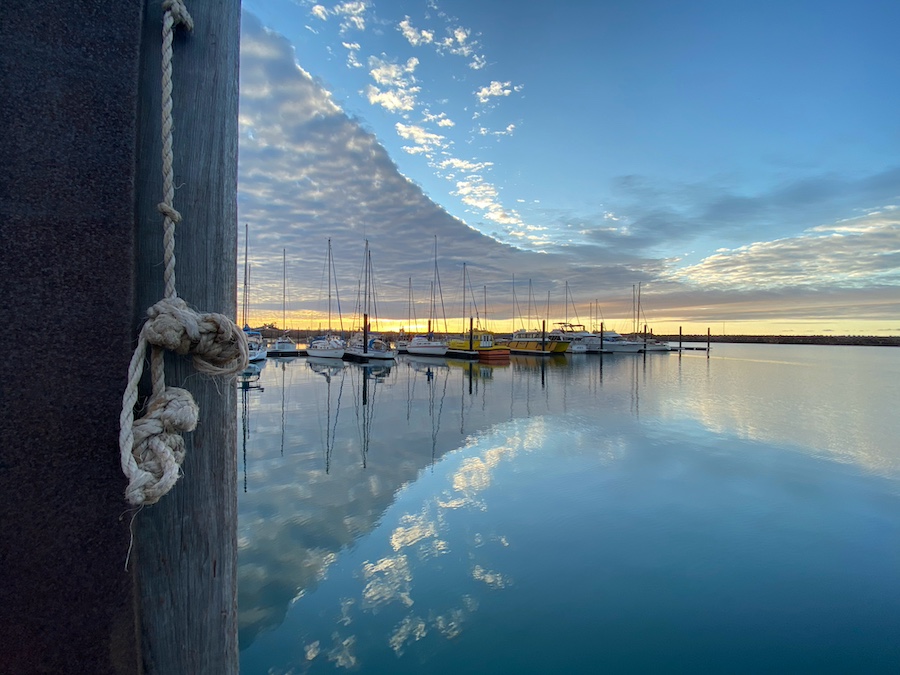
While not traditionally known for coral reefs, South Australia offers a unique diving experience with shipwrecks, abundant marine life, and even bioluminescence. Some of the must-dive locations here include:
Neptune Islands: Home to a resident population of Great White Sharks, divers can experience these awe-inspiring creatures from the safety of a specially designed cage.
Whyalla: This former shipbuilding center offers a variety of wreck dives, suitable for divers of all experience levels. Encounter a variety of marine life inhabiting these artificial reefs.
Victor Harbor: Venture into a realm of bioluminescence! Night dives here offer the magical experience of witnessing plankton illuminate the water with an ethereal glow.
What is the best time of year to visit South Australia for diving?
Great White Shark Cage Diving (May to July): This is the prime time to see Great White Sharks at Neptune Islands. Water temperatures are on the cooler side (around 15-18°C).
Temperate Diving (Year-round): South Australia offers year-round diving with water temperatures ranging from 15°C to 24°C. Visibility can be good, but some dive sites might be affected by seasonal currents.
Liveaboards in Australia
Liveaboards offer an unparalleled scuba diving experience. Imagine waking up to pristine dive sites untouched by tourism, maximizing your dives with prepped gear and nitrox options.
Ditch the daily boat commutes and consider a liveaboard trip. Forget packing and unpacking – dive multiple times a day, fueled by delicious meals. Relax in comfortable cabins, unwind on sundecks, and forge friendships with fellow divers.
Liveaboards aren’t just convenience, they’re expertise. Skilled captains and divemasters guide you through diverse underwater landscapes, maximizing your chances of encountering unique marine life. Enjoy night dives, starlit skies, and unforgettable wildlife encounters like dolphins leaping alongside the boat. Reconnect with yourself and nature in a paradise far away from your digitally connected life.
Diver Friendly Resorts In Australia
Here are some of our favorite diver friendly resorts.
Sea Change Beachfront Apartments, Trinity Beach
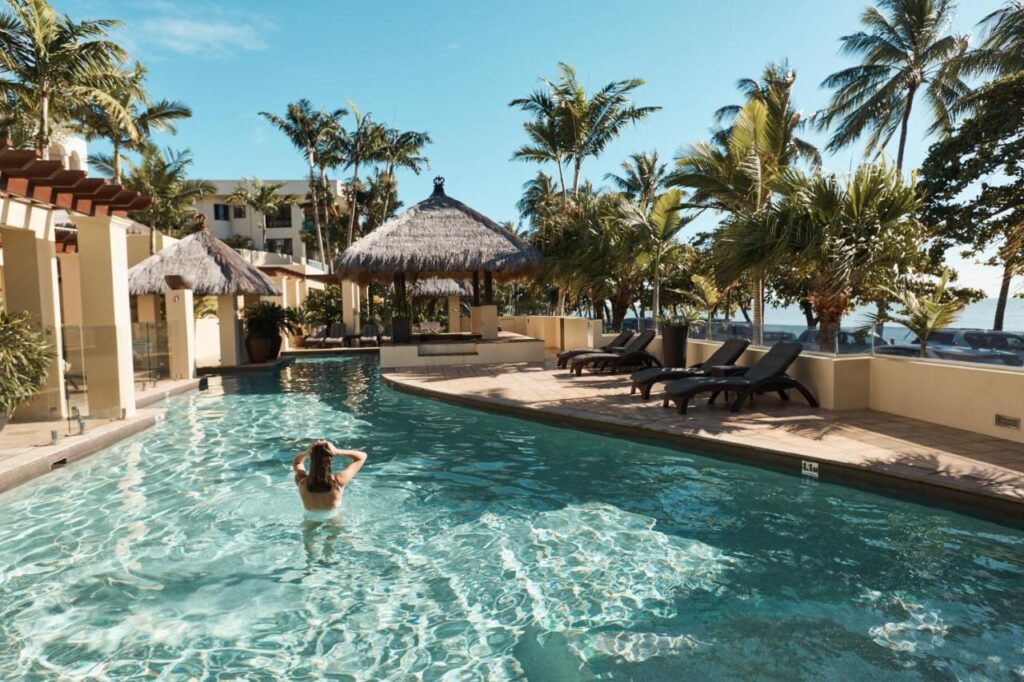
Located on Trinity Beach, just 15 minutes north of Cairns. It offers luxurious 5-star apartments with breathtaking views of the Coral Sea from each private balcony. Each spacious apartment features a spa bath and a fully equipped kitchen. The tour desk can arrange diving excursions.
Book with Expedia or Booking.com
Pullman Reef Hotel Casino, Cairns

A luxury hotel located in Cairns city center. Situated close to the Reef Fleet Terminal, which is the main departure point for many dive boats and tours heading to the Great Barrier Reef. The staff are experienced in catering to divers, providing knowledgeable assistance and recommendations.
Book with Expedia or Booking.com
Qualia Whitsundays
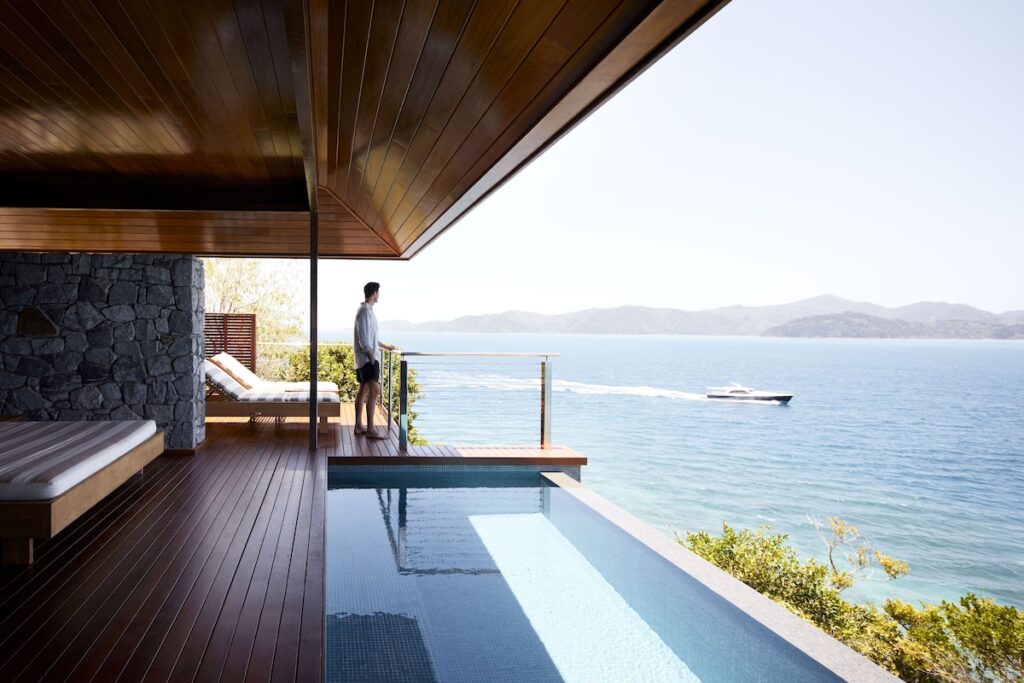
Located on Hamilton Island, Qualia is a top recommendation. It’s a luxurious resort that offers a range of activities including diving excursions to the Great Barrier Reef. Additionally, it provides high-quality amenities, like a full-service spa, private plunge pools, stunning views, and exceptional service.
Book with Expedia
Port Lincoln Hotel, South Australia
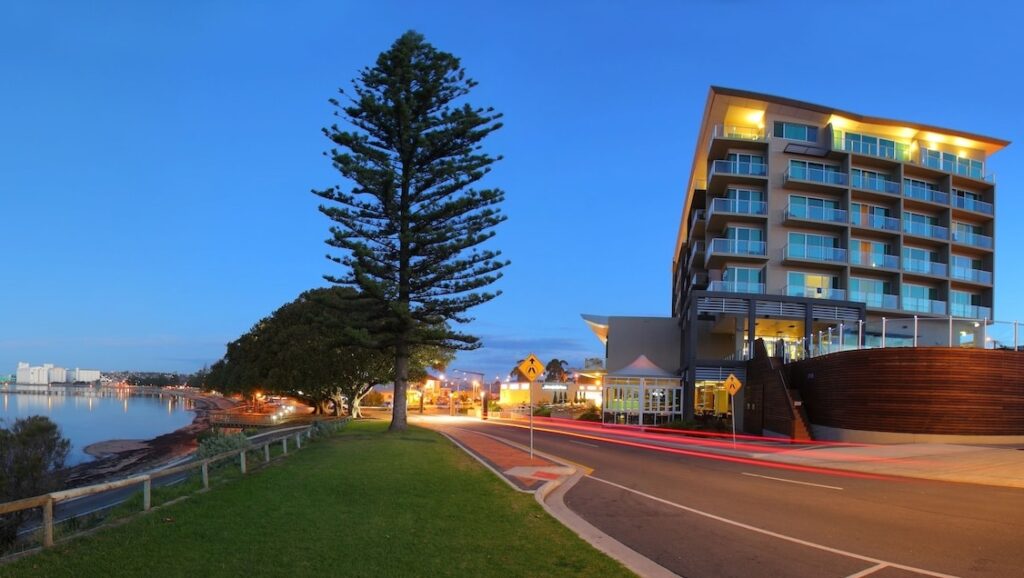
Port Lincoln is known as the “Seafood Capital of Australia” and is famous for its diving opportunities, including cage diving with great white sharks and exploring shipwrecks. The hotel offers stunning views of Boston Bay and provides comfortable accommodation with modern amenities, including an outdoor pool, fitness center, and on-site dining.
Book with Expedia or Booking.com
Mantarays Ningaloo Beach Resort

This resort offers a great location on the beachfront and has its own diving center called Red Sea Divers. They offer courses for all levels and fantastic day trips to explore the reefs and wrecks of the Red Sea. The resort also features a large outdoor pool, a pool bar, a buffet restaurant, and a variety of other amenities.
Book with Expedia or Booking.com
Off the beaten path
Escape the crowds and uncover the beauty and serenity of some lesser known spots, where adventure meets relaxation in the most spectacular settings.
Rottnest Island, Western Australia

This pristine island just off the coast of Perth offers an extraordinary underwater adventure. Diving here is just exceptional. Stay at Warders Hotel in Fremantle. Book your dive trip with Perth Scuba.
Book with Expedia or Booking.com
Julian Rocks, New South Wales

Here at this marine reserve the warm waters of the Coral Sea meet the cooler currents from the south, creating a unique environment that supports a very diverse array of marine life. Stay at Elements Of Byron in Byron Bay. Book your dive trip with Sundive.
Book with Expedia or Booking.com


